Abstract
Human skin and lung mast cells and rodent peritoneal mast cells contain a carboxypeptidase in their secretory granules. We have screened human lung cDNA libraries with a mouse mast cell carboxypeptidase A (MC-CPA) cDNA probe to isolate a near-full-length cDNA that encodes human MC-CPA. The 5' end of the human MC-CPA transcript was defined by direct mRNA sequencing and by isolation and partial sequencing of the human MC-CPA gene. Human MC-CPA is predicted to be translated as a 417 amino acid preproenzyme which includes a 15 amino acid signal peptide and a 94 amino acid activation peptide. The mature human MC-CPA enzyme has a predicted size of 36.1 kDa, a net positive charge of 16 at neutral pH, and 86% amino acid sequence identity with mouse MC-CPA. DNA blot analyses showed that human MC-CPA mRNA is transcribed from a single locus in the human genome. Comparison of the human MC-CPA with mouse MC-CPA and with three rat pancreatic carboxypeptidases shows that these enzymes are encoded by distinct but homologous genes.
Full text
PDF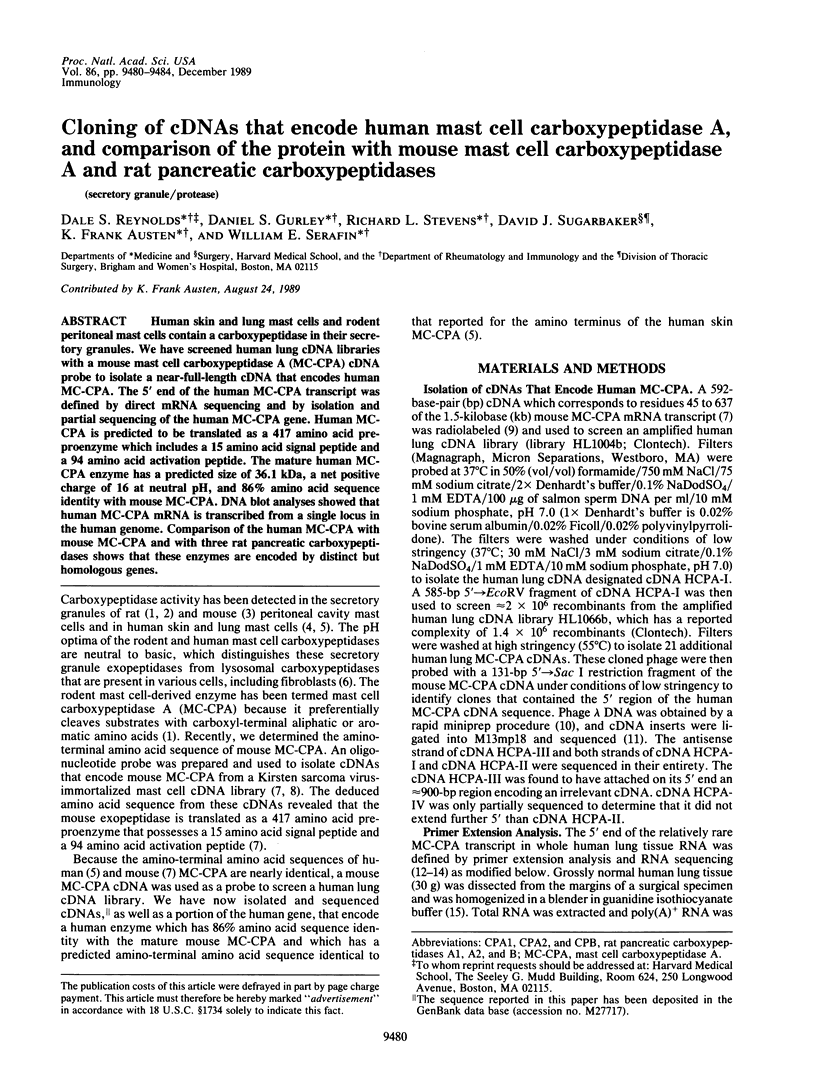
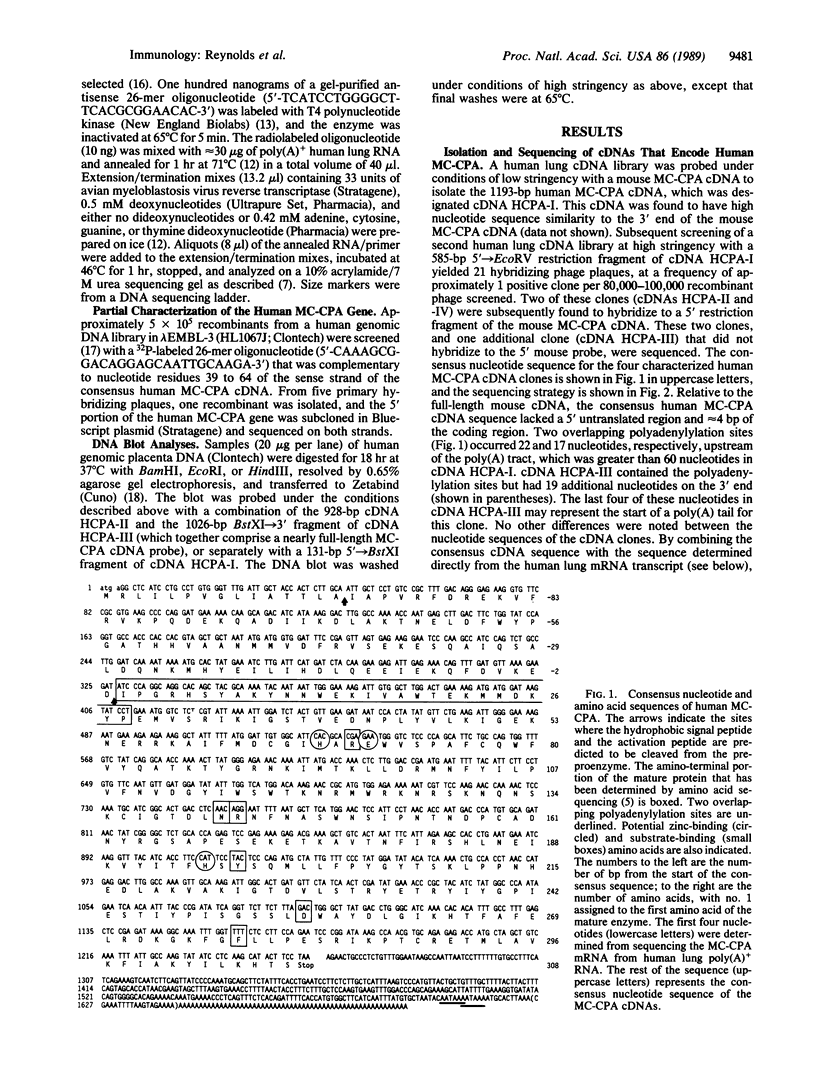
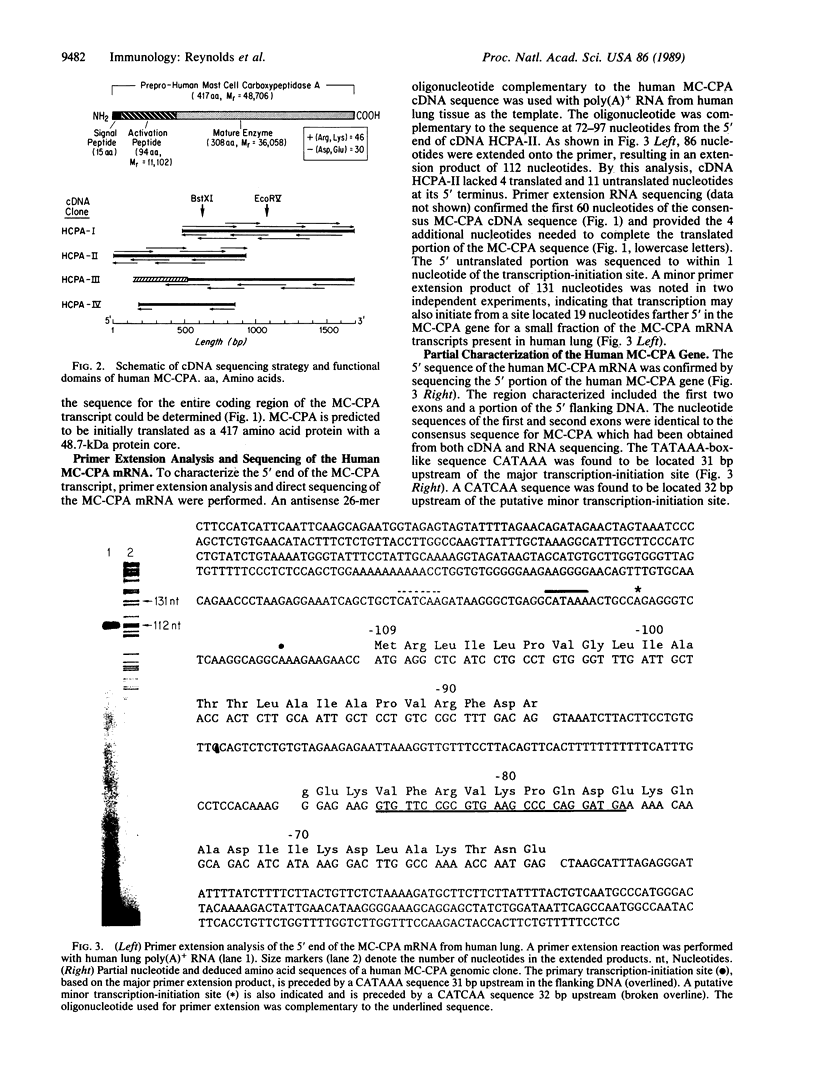
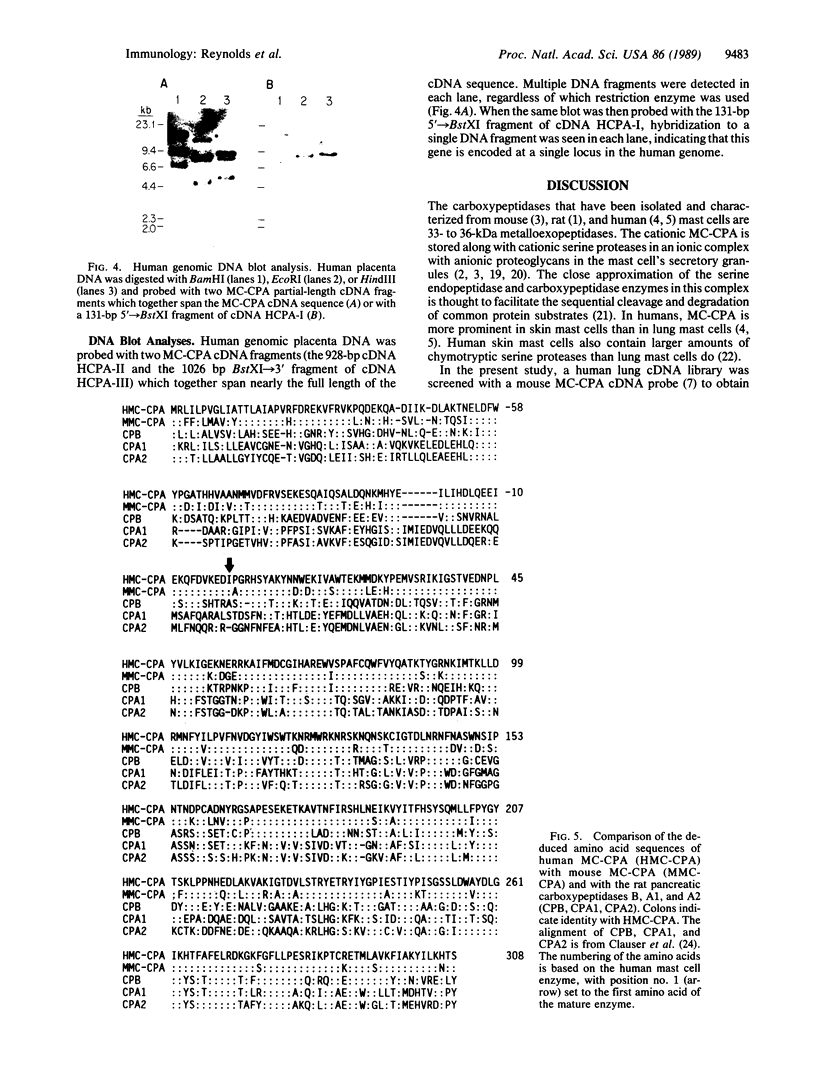
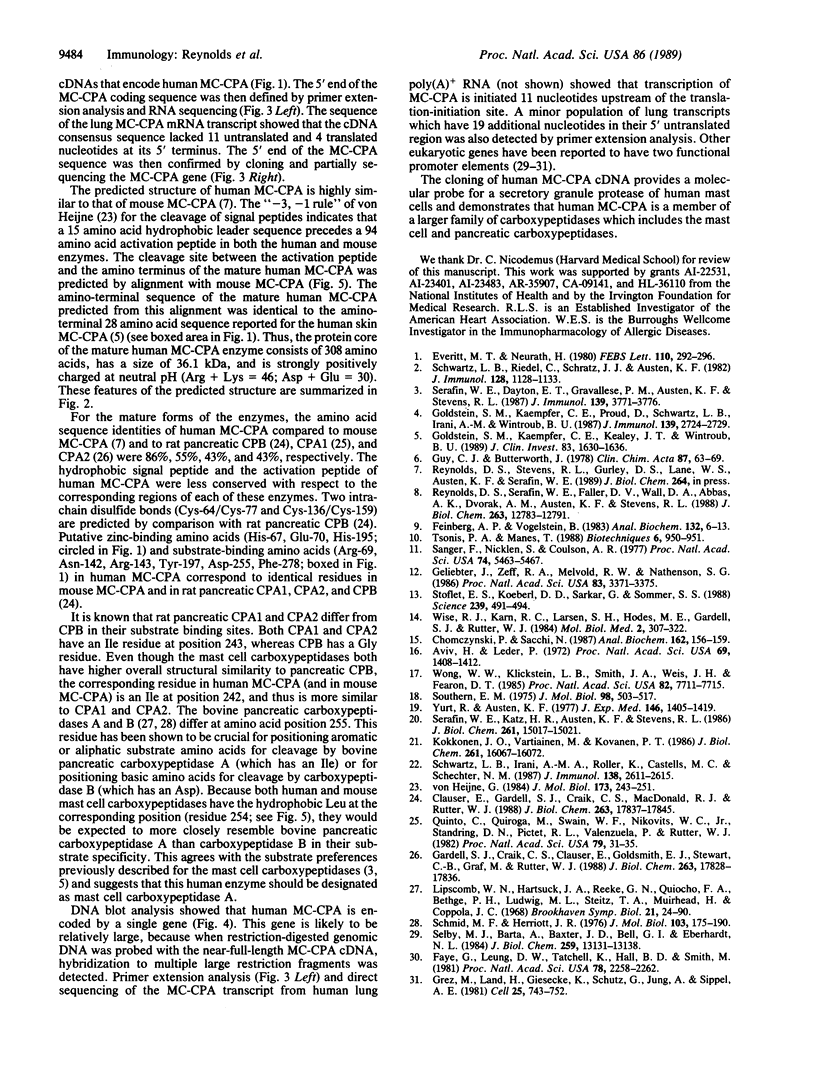
Images in this article
Selected References
These references are in PubMed. This may not be the complete list of references from this article.
- Aviv H., Leder P. Purification of biologically active globin messenger RNA by chromatography on oligothymidylic acid-cellulose. Proc Natl Acad Sci U S A. 1972 Jun;69(6):1408–1412. doi: 10.1073/pnas.69.6.1408. [DOI] [PMC free article] [PubMed] [Google Scholar]
- Chomczynski P., Sacchi N. Single-step method of RNA isolation by acid guanidinium thiocyanate-phenol-chloroform extraction. Anal Biochem. 1987 Apr;162(1):156–159. doi: 10.1006/abio.1987.9999. [DOI] [PubMed] [Google Scholar]
- Clauser E., Gardell S. J., Craik C. S., MacDonald R. J., Rutter W. J. Structural characterization of the rat carboxypeptidase A1 and B genes. Comparative analysis of the rat carboxypeptidase gene family. J Biol Chem. 1988 Nov 25;263(33):17837–17845. [PubMed] [Google Scholar]
- Everitt M. T., Neurath H. Rat peritoneal mast cell carboxypeptidase: localization, purification, and enzymatic properties. FEBS Lett. 1980 Feb 11;110(2):292–296. doi: 10.1016/0014-5793(80)80095-0. [DOI] [PubMed] [Google Scholar]
- Faye G., Leung D. W., Tatchell K., Hall B. D., Smith M. Deletion mapping of sequences essential for in vivo transcription of the iso-1-cytochrome c gene. Proc Natl Acad Sci U S A. 1981 Apr;78(4):2258–2262. doi: 10.1073/pnas.78.4.2258. [DOI] [PMC free article] [PubMed] [Google Scholar]
- Feinberg A. P., Vogelstein B. A technique for radiolabeling DNA restriction endonuclease fragments to high specific activity. Anal Biochem. 1983 Jul 1;132(1):6–13. doi: 10.1016/0003-2697(83)90418-9. [DOI] [PubMed] [Google Scholar]
- Gardell S. J., Craik C. S., Clauser E., Goldsmith E. J., Stewart C. B., Graf M., Rutter W. J. A novel rat carboxypeptidase, CPA2: characterization, molecular cloning, and evolutionary implications on substrate specificity in the carboxypeptidase gene family. J Biol Chem. 1988 Nov 25;263(33):17828–17836. [PubMed] [Google Scholar]
- Geliebter J., Zeff R. A., Melvold R. W., Nathenson S. G. Mitotic recombination in germ cells generated two major histocompatibility complex mutant genes shown to be identical by RNA sequence analysis: Kbm9 and Kbm6. Proc Natl Acad Sci U S A. 1986 May;83(10):3371–3375. doi: 10.1073/pnas.83.10.3371. [DOI] [PMC free article] [PubMed] [Google Scholar]
- Goldstein S. M., Kaempfer C. E., Kealey J. T., Wintroub B. U. Human mast cell carboxypeptidase. Purification and characterization. J Clin Invest. 1989 May;83(5):1630–1636. doi: 10.1172/JCI114061. [DOI] [PMC free article] [PubMed] [Google Scholar]
- Goldstein S. M., Kaempfer C. E., Proud D., Schwartz L. B., Irani A. M., Wintroub B. U. Detection and partial characterization of a human mast cell carboxypeptidase. J Immunol. 1987 Oct 15;139(8):2724–2729. [PubMed] [Google Scholar]
- Grez M., Land H., Giesecke K., Schütz G., Jung A., Sippel A. E. Multiple mRNAs are generated from the chicken lysozyme gene. Cell. 1981 Sep;25(3):743–752. doi: 10.1016/0092-8674(81)90182-3. [DOI] [PubMed] [Google Scholar]
- Guy G. J., Butterworth J. Carboxypeptidase A activity of cultured skin fibroblasts and relationship to cystic fibrosis. Clin Chim Acta. 1978 Jul 1;87(1):63–69. doi: 10.1016/0009-8981(78)90058-x. [DOI] [PubMed] [Google Scholar]
- Kokkonen J. O., Vartiainen M., Kovanen P. T. Low density lipoprotein degradation by secretory granules of rat mast cells. Sequential degradation of apolipoprotein B by granule chymase and carboxypeptidase A. J Biol Chem. 1986 Dec 5;261(34):16067–16072. [PubMed] [Google Scholar]
- Lipscomb W. N., Hartsuck J. A., Reeke G. N., Jr, Quiocho F. A., Bethge P. H., Ludwig M. L., Steitz T. A., Muirhead H., Coppola J. C. The structure of carboxypeptidase A. VII. The 2.0-angstrom resolution studies of the enzyme and of its complex with glycyltyrosine, and mechanistic deductions. Brookhaven Symp Biol. 1968 Jun;21(1):24–90. [PubMed] [Google Scholar]
- Quinto C., Quiroga M., Swain W. F., Nikovits W. C., Jr, Standring D. N., Pictet R. L., Valenzuela P., Rutter W. J. Rat preprocarboxypeptidase A: cDNA sequence and preliminary characterization of the gene. Proc Natl Acad Sci U S A. 1982 Jan;79(1):31–35. doi: 10.1073/pnas.79.1.31. [DOI] [PMC free article] [PubMed] [Google Scholar]
- Reynolds D. S., Serafin W. E., Faller D. V., Wall D. A., Abbas A. K., Dvorak A. M., Austen K. F., Stevens R. L. Immortalization of murine connective tissue-type mast cells at multiple stages of their differentiation by coculture of splenocytes with fibroblasts that produce Kirsten sarcoma virus. J Biol Chem. 1988 Sep 5;263(25):12783–12791. [PubMed] [Google Scholar]
- Sanger F., Nicklen S., Coulson A. R. DNA sequencing with chain-terminating inhibitors. Proc Natl Acad Sci U S A. 1977 Dec;74(12):5463–5467. doi: 10.1073/pnas.74.12.5463. [DOI] [PMC free article] [PubMed] [Google Scholar]
- Schmid M. F., Herriott J. R. Structure of carboxypeptidase B at 2-8 A resolution. J Mol Biol. 1976 May 5;103(1):175–190. doi: 10.1016/0022-2836(76)90058-9. [DOI] [PubMed] [Google Scholar]
- Schwartz L. B., Irani A. M., Roller K., Castells M. C., Schechter N. M. Quantitation of histamine, tryptase, and chymase in dispersed human T and TC mast cells. J Immunol. 1987 Apr 15;138(8):2611–2615. [PubMed] [Google Scholar]
- Schwartz L. B., Riedel C., Schratz J. J., Austen K. F. Localization of carboxypeptidase A to the macromolecular heparin proteoglycan-protein complex in secretory granules of rat serosal mast cells. J Immunol. 1982 Mar;128(3):1128–1133. [PubMed] [Google Scholar]
- Selby M. J., Barta A., Baxter J. D., Bell G. I., Eberhardt N. L. Analysis of a major human chorionic somatomammotropin gene. Evidence for two functional promoter elements. J Biol Chem. 1984 Nov 10;259(21):13131–13138. [PubMed] [Google Scholar]
- Serafin W. E., Dayton E. T., Gravallese P. M., Austen K. F., Stevens R. L. Carboxypeptidase A in mouse mast cells. Identification, characterization, and use as a differentiation marker. J Immunol. 1987 Dec 1;139(11):3771–3776. [PubMed] [Google Scholar]
- Serafin W. E., Katz H. R., Austen K. F., Stevens R. L. Complexes of heparin proteoglycans, chondroitin sulfate E proteoglycans, and [3H]diisopropyl fluorophosphate-binding proteins are exocytosed from activated mouse bone marrow-derived mast cells. J Biol Chem. 1986 Nov 15;261(32):15017–15021. [PubMed] [Google Scholar]
- Southern E. M. Detection of specific sequences among DNA fragments separated by gel electrophoresis. J Mol Biol. 1975 Nov 5;98(3):503–517. doi: 10.1016/s0022-2836(75)80083-0. [DOI] [PubMed] [Google Scholar]
- Stoflet E. S., Koeberl D. D., Sarkar G., Sommer S. S. Genomic amplification with transcript sequencing. Science. 1988 Jan 29;239(4839):491–494. doi: 10.1126/science.3340835. [DOI] [PubMed] [Google Scholar]
- Tsonis P. A., Manes T. Rapid phage DNA isolation without the use of enzymes. Biotechniques. 1988 Nov-Dec;6(10):950–951. [PubMed] [Google Scholar]
- Wise R. J., Karn R. C., Larsen S. H., Hodes M. E., Gardell S. J., Rutter W. J. A complementary DNA sequence that predicts a human pancreatic amylase primary structure consistent with the electrophoretic mobility of the common isozyme, Amy2 A. Mol Biol Med. 1984 Oct;2(5):307–322. [PubMed] [Google Scholar]
- Wong W. W., Klickstein L. B., Smith J. A., Weis J. H., Fearon D. T. Identification of a partial cDNA clone for the human receptor for complement fragments C3b/C4b. Proc Natl Acad Sci U S A. 1985 Nov;82(22):7711–7715. doi: 10.1073/pnas.82.22.7711. [DOI] [PMC free article] [PubMed] [Google Scholar]
- Yurt R., Austen K. F. Preparative purification of the rat mast cell chymase: characterization and interaction with granule components. J Exp Med. 1977 Nov 1;146(5):1405–1419. doi: 10.1084/jem.146.5.1405. [DOI] [PMC free article] [PubMed] [Google Scholar]
- von Heijne G. How signal sequences maintain cleavage specificity. J Mol Biol. 1984 Feb 25;173(2):243–251. doi: 10.1016/0022-2836(84)90192-x. [DOI] [PubMed] [Google Scholar]




